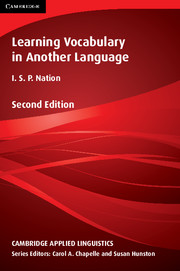Book contents
- Frontmatter
- Contents
- Series editors' preface
- Acknowledgements
- Introduction
- 1 The goals of vocabulary learning
- 2 Knowing a word
- 3 Teaching and explaining vocabulary
- 4 Vocabulary and listening and speaking
- 5 Vocabulary and reading and writing
- 6 Specialised uses of vocabulary
- 7 Vocabulary-learning strategies
- 8 Learning words from context
- 9 Word parts
- 10 Using dictionaries
- 11 Deliberate learning from word cards
- 12 Finding and learning multiword units
- 13 Testing vocabulary knowledge and use
- 14 Designing the vocabulary component of a language course
- Appendices
- Subject index
- Author index
12 - Finding and learning multiword units
Published online by Cambridge University Press: 15 February 2018
- Frontmatter
- Contents
- Series editors' preface
- Acknowledgements
- Introduction
- 1 The goals of vocabulary learning
- 2 Knowing a word
- 3 Teaching and explaining vocabulary
- 4 Vocabulary and listening and speaking
- 5 Vocabulary and reading and writing
- 6 Specialised uses of vocabulary
- 7 Vocabulary-learning strategies
- 8 Learning words from context
- 9 Word parts
- 10 Using dictionaries
- 11 Deliberate learning from word cards
- 12 Finding and learning multiword units
- 13 Testing vocabulary knowledge and use
- 14 Designing the vocabulary component of a language course
- Appendices
- Subject index
- Author index
Summary
What are multiword units?
There are four major kinds of multiword units: (1) A multiword unit can be a group of words that commonly occur together, like ‘take a chance’; (2) it can be a group of words where the meaning of the phrase is not obvious from the meaning of the parts, as with ‘by and large’ or ‘be taken in’ (be tricked); (3) it can simply refer to all the combinations of a particular word or type of word and its accompanying words whether they are highly frequent, strongly associated, or not; and (4) it can refer to word groups that are intuitively seen as being formulaic sequences, that is, items stored as single choices (see Durrant and Schmitt, 2009: 159, for an excellent discussion of these four types).
These different kinds of multiword units are based on a variety of criteria – frequency of co-occurrence, compositionality (do the parts make the whole?), form and storage, and so it is not too surprising that there is a large and growing list of terms to cover multiword units. Wray (2000) lists around 50 terms including composites, conventionalised forms, idiomatic phrases, routine formulae, phrasal expressions, and stock utterances, just to describe formulaic sequences, and there are at least as many again to describe multiword units more generally (lexical bundles, collocations, phrasal units, multiword units). The large number of terms reflects the different purposes for looking at multiword units, and the fragmented nature of research in this area. Walker (2011) suggests that the definition of what is a multiword unit affects what appears in learners' dictionaries. A major issue in research on multiword units is the need to set clear criteria and, where possible, develop standard terminology to describe the different types of multiword units.
Information
- Type
- Chapter
- Information
- Learning Vocabulary in Another Language , pp. 479 - 513Publisher: Cambridge University PressPrint publication year: 2013
